Aesthetics and Individual Spa Choices: Dissertation Research
VerifiedAdded on 2019/12/18
|40
|14493
|269
Thesis and Dissertation
AI Summary
This dissertation investigates the impact of aesthetics on individual choices for spas, focusing on historical evolution, different spa types, sensory designs, architecture, and their influence on consumer behavior. The study examines the evolution of spas from ancient practices to modern concepts, highlighting the integration of thermal and hydrotherapy. It explores various spa types and features, including sensory designs and architecture, to understand how these elements affect individual preferences. The research analyzes the preferences of spa clients related to scent and sound. The dissertation also provides the data analysis and conclusion of the conducted research. The study uses case studies of Peter Zumthor in Switzerland, Aqua Sulis Rome Bath in Britain, and Soneva Kiri in Thailand to support the findings and provide recommendations for the spa industry. The dissertation is based on the research questions and objectives, which are the historical evolution of spa, different types of spas and their features, factors associated with sensory designs and architecture of spa, and how the aesthetics of spa affect an individual choice.
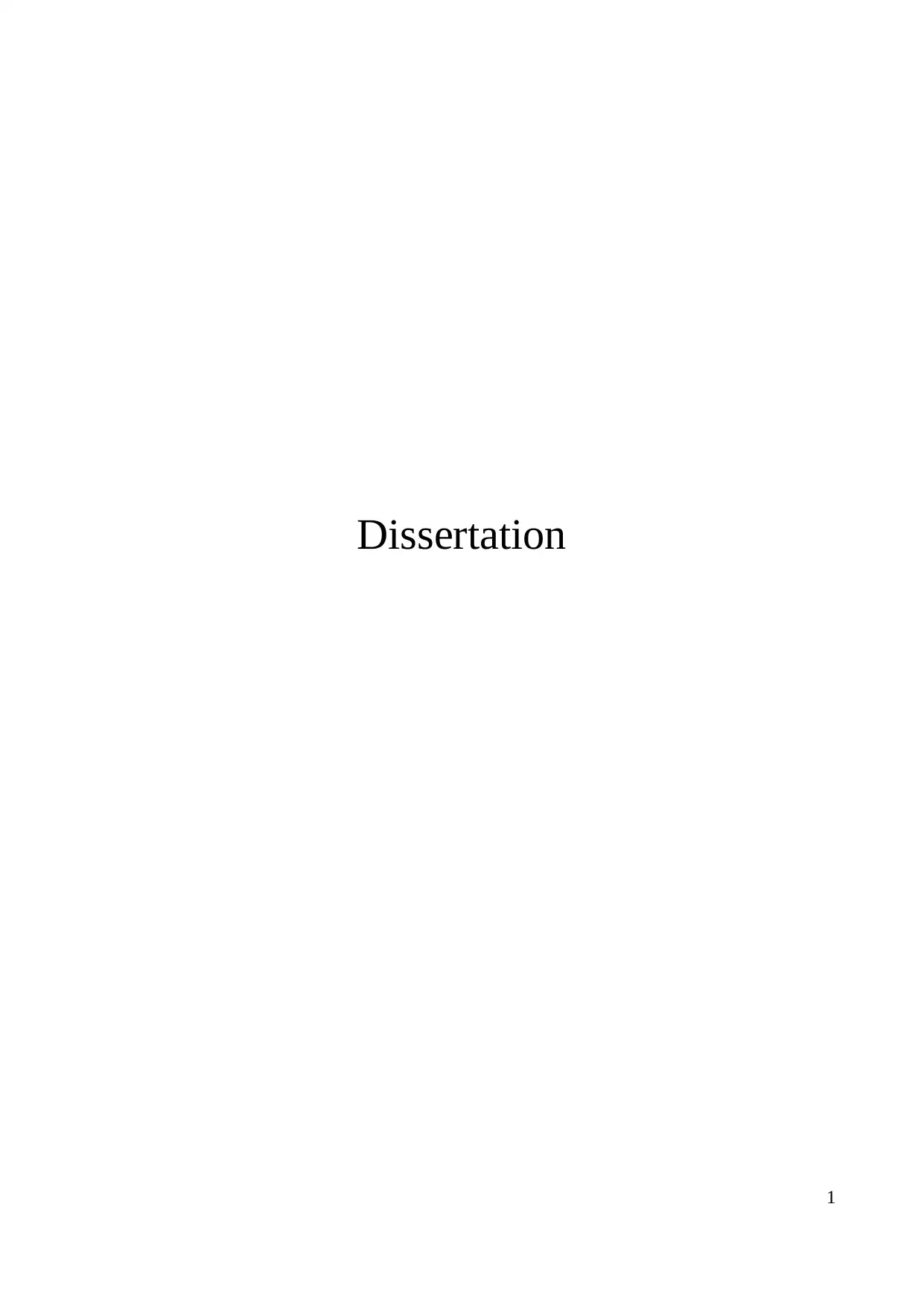
Dissertation
1
1
Paraphrase This Document
Need a fresh take? Get an instant paraphrase of this document with our AI Paraphraser
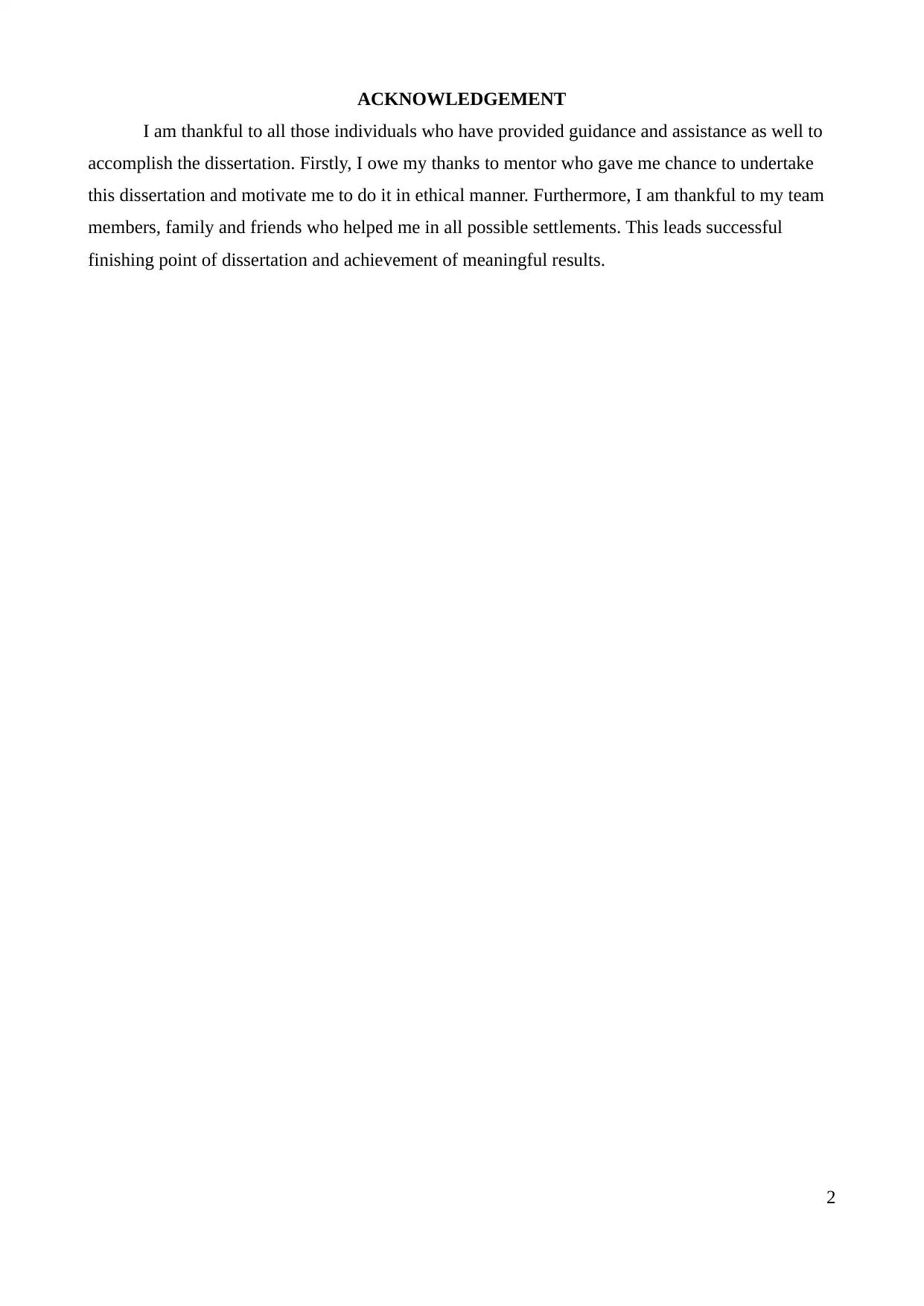
ACKNOWLEDGEMENT
I am thankful to all those individuals who have provided guidance and assistance as well to
accomplish the dissertation. Firstly, I owe my thanks to mentor who gave me chance to undertake
this dissertation and motivate me to do it in ethical manner. Furthermore, I am thankful to my team
members, family and friends who helped me in all possible settlements. This leads successful
finishing point of dissertation and achievement of meaningful results.
2
I am thankful to all those individuals who have provided guidance and assistance as well to
accomplish the dissertation. Firstly, I owe my thanks to mentor who gave me chance to undertake
this dissertation and motivate me to do it in ethical manner. Furthermore, I am thankful to my team
members, family and friends who helped me in all possible settlements. This leads successful
finishing point of dissertation and achievement of meaningful results.
2
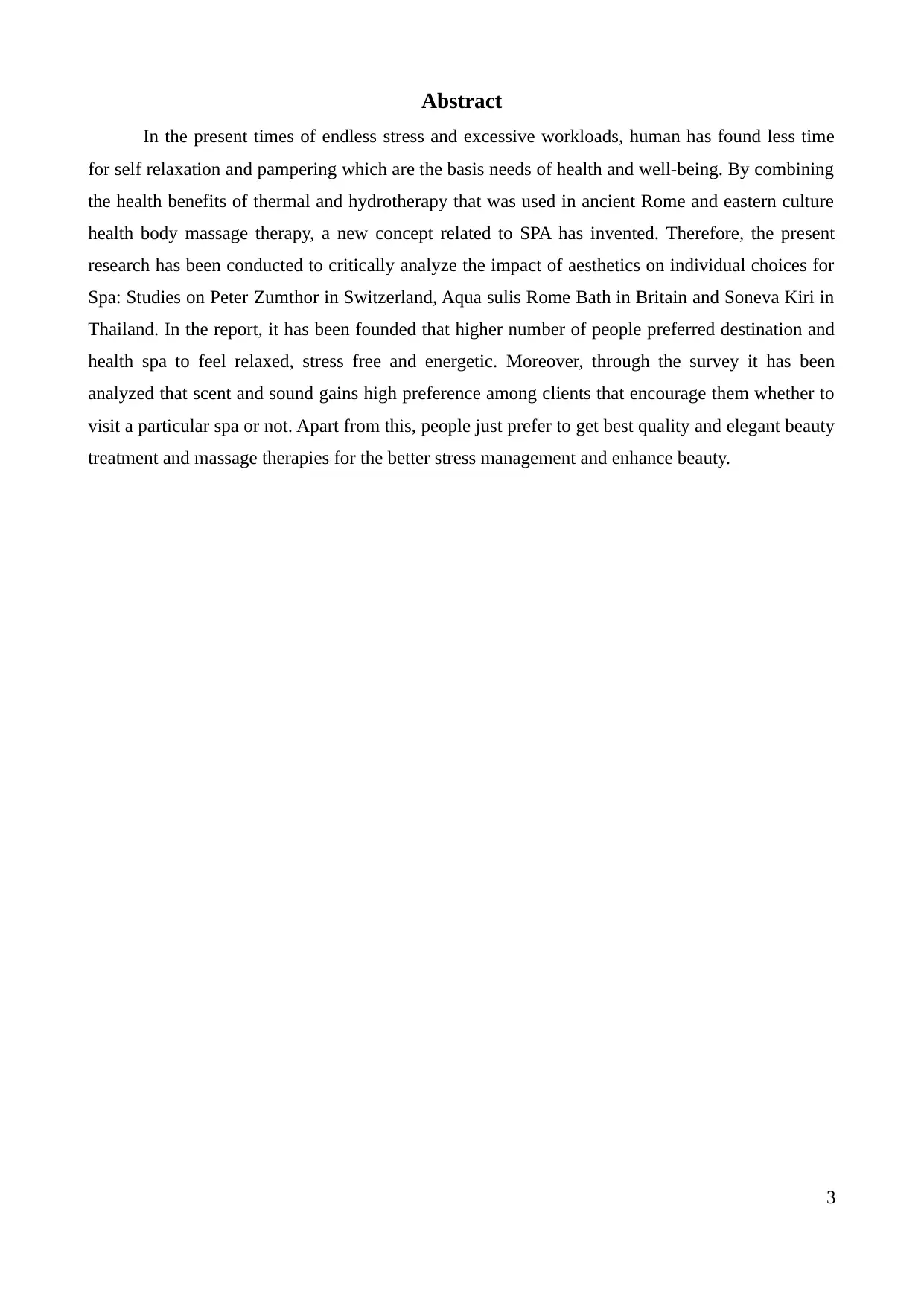
Abstract
In the present times of endless stress and excessive workloads, human has found less time
for self relaxation and pampering which are the basis needs of health and well-being. By combining
the health benefits of thermal and hydrotherapy that was used in ancient Rome and eastern culture
health body massage therapy, a new concept related to SPA has invented. Therefore, the present
research has been conducted to critically analyze the impact of aesthetics on individual choices for
Spa: Studies on Peter Zumthor in Switzerland, Aqua sulis Rome Bath in Britain and Soneva Kiri in
Thailand. In the report, it has been founded that higher number of people preferred destination and
health spa to feel relaxed, stress free and energetic. Moreover, through the survey it has been
analyzed that scent and sound gains high preference among clients that encourage them whether to
visit a particular spa or not. Apart from this, people just prefer to get best quality and elegant beauty
treatment and massage therapies for the better stress management and enhance beauty.
3
In the present times of endless stress and excessive workloads, human has found less time
for self relaxation and pampering which are the basis needs of health and well-being. By combining
the health benefits of thermal and hydrotherapy that was used in ancient Rome and eastern culture
health body massage therapy, a new concept related to SPA has invented. Therefore, the present
research has been conducted to critically analyze the impact of aesthetics on individual choices for
Spa: Studies on Peter Zumthor in Switzerland, Aqua sulis Rome Bath in Britain and Soneva Kiri in
Thailand. In the report, it has been founded that higher number of people preferred destination and
health spa to feel relaxed, stress free and energetic. Moreover, through the survey it has been
analyzed that scent and sound gains high preference among clients that encourage them whether to
visit a particular spa or not. Apart from this, people just prefer to get best quality and elegant beauty
treatment and massage therapies for the better stress management and enhance beauty.
3
⊘ This is a preview!⊘
Do you want full access?
Subscribe today to unlock all pages.

Trusted by 1+ million students worldwide
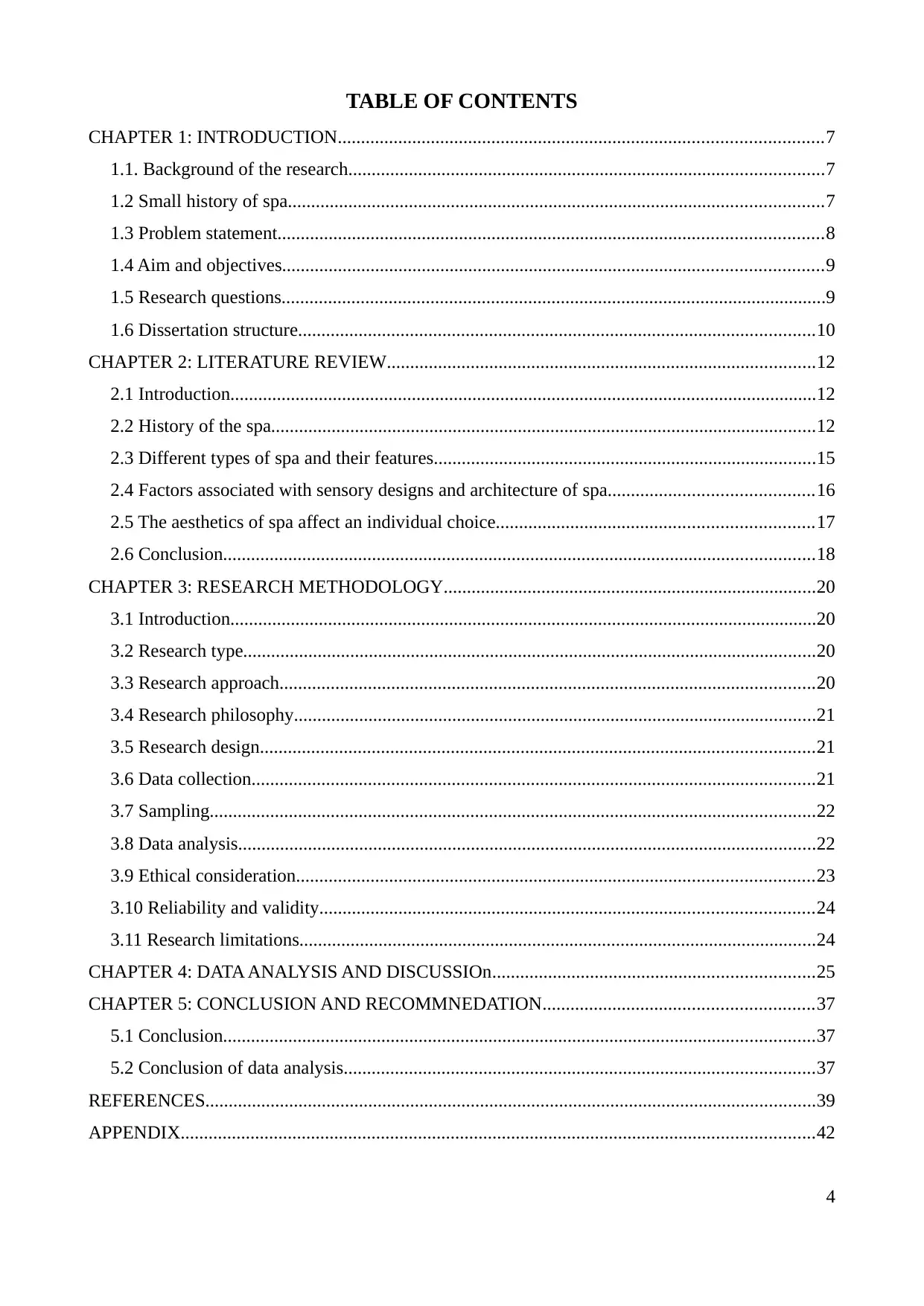
TABLE OF CONTENTS
CHAPTER 1: INTRODUCTION........................................................................................................7
1.1. Background of the research......................................................................................................7
1.2 Small history of spa...................................................................................................................7
1.3 Problem statement.....................................................................................................................8
1.4 Aim and objectives....................................................................................................................9
1.5 Research questions.....................................................................................................................9
1.6 Dissertation structure...............................................................................................................10
CHAPTER 2: LITERATURE REVIEW............................................................................................12
2.1 Introduction..............................................................................................................................12
2.2 History of the spa.....................................................................................................................12
2.3 Different types of spa and their features..................................................................................15
2.4 Factors associated with sensory designs and architecture of spa............................................16
2.5 The aesthetics of spa affect an individual choice....................................................................17
2.6 Conclusion...............................................................................................................................18
CHAPTER 3: RESEARCH METHODOLOGY................................................................................20
3.1 Introduction..............................................................................................................................20
3.2 Research type...........................................................................................................................20
3.3 Research approach...................................................................................................................20
3.4 Research philosophy................................................................................................................21
3.5 Research design.......................................................................................................................21
3.6 Data collection.........................................................................................................................21
3.7 Sampling..................................................................................................................................22
3.8 Data analysis............................................................................................................................22
3.9 Ethical consideration...............................................................................................................23
3.10 Reliability and validity..........................................................................................................24
3.11 Research limitations...............................................................................................................24
CHAPTER 4: DATA ANALYSIS AND DISCUSSIOn.....................................................................25
CHAPTER 5: CONCLUSION AND RECOMMNEDATION..........................................................37
5.1 Conclusion...............................................................................................................................37
5.2 Conclusion of data analysis.....................................................................................................37
REFERENCES...................................................................................................................................39
APPENDIX........................................................................................................................................42
4
CHAPTER 1: INTRODUCTION........................................................................................................7
1.1. Background of the research......................................................................................................7
1.2 Small history of spa...................................................................................................................7
1.3 Problem statement.....................................................................................................................8
1.4 Aim and objectives....................................................................................................................9
1.5 Research questions.....................................................................................................................9
1.6 Dissertation structure...............................................................................................................10
CHAPTER 2: LITERATURE REVIEW............................................................................................12
2.1 Introduction..............................................................................................................................12
2.2 History of the spa.....................................................................................................................12
2.3 Different types of spa and their features..................................................................................15
2.4 Factors associated with sensory designs and architecture of spa............................................16
2.5 The aesthetics of spa affect an individual choice....................................................................17
2.6 Conclusion...............................................................................................................................18
CHAPTER 3: RESEARCH METHODOLOGY................................................................................20
3.1 Introduction..............................................................................................................................20
3.2 Research type...........................................................................................................................20
3.3 Research approach...................................................................................................................20
3.4 Research philosophy................................................................................................................21
3.5 Research design.......................................................................................................................21
3.6 Data collection.........................................................................................................................21
3.7 Sampling..................................................................................................................................22
3.8 Data analysis............................................................................................................................22
3.9 Ethical consideration...............................................................................................................23
3.10 Reliability and validity..........................................................................................................24
3.11 Research limitations...............................................................................................................24
CHAPTER 4: DATA ANALYSIS AND DISCUSSIOn.....................................................................25
CHAPTER 5: CONCLUSION AND RECOMMNEDATION..........................................................37
5.1 Conclusion...............................................................................................................................37
5.2 Conclusion of data analysis.....................................................................................................37
REFERENCES...................................................................................................................................39
APPENDIX........................................................................................................................................42
4
Paraphrase This Document
Need a fresh take? Get an instant paraphrase of this document with our AI Paraphraser
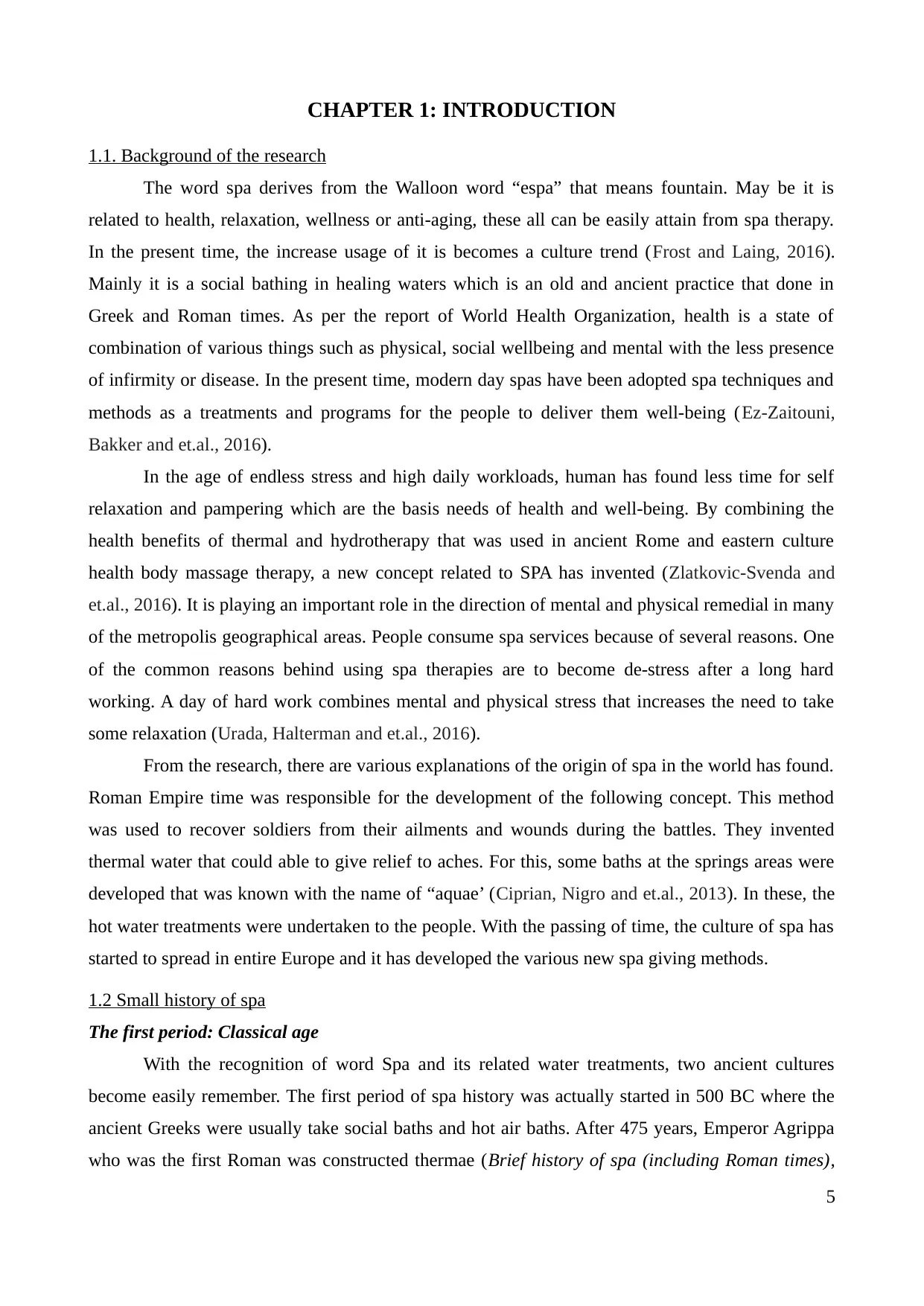
CHAPTER 1: INTRODUCTION
1.1. Background of the research
The word spa derives from the Walloon word “espa” that means fountain. May be it is
related to health, relaxation, wellness or anti-aging, these all can be easily attain from spa therapy.
In the present time, the increase usage of it is becomes a culture trend (Frost and Laing, 2016).
Mainly it is a social bathing in healing waters which is an old and ancient practice that done in
Greek and Roman times. As per the report of World Health Organization, health is a state of
combination of various things such as physical, social wellbeing and mental with the less presence
of infirmity or disease. In the present time, modern day spas have been adopted spa techniques and
methods as a treatments and programs for the people to deliver them well-being (Ez-Zaitouni,
Bakker and et.al., 2016).
In the age of endless stress and high daily workloads, human has found less time for self
relaxation and pampering which are the basis needs of health and well-being. By combining the
health benefits of thermal and hydrotherapy that was used in ancient Rome and eastern culture
health body massage therapy, a new concept related to SPA has invented (Zlatkovic-Svenda and
et.al., 2016). It is playing an important role in the direction of mental and physical remedial in many
of the metropolis geographical areas. People consume spa services because of several reasons. One
of the common reasons behind using spa therapies are to become de-stress after a long hard
working. A day of hard work combines mental and physical stress that increases the need to take
some relaxation (Urada, Halterman and et.al., 2016).
From the research, there are various explanations of the origin of spa in the world has found.
Roman Empire time was responsible for the development of the following concept. This method
was used to recover soldiers from their ailments and wounds during the battles. They invented
thermal water that could able to give relief to aches. For this, some baths at the springs areas were
developed that was known with the name of “aquae’ (Ciprian, Nigro and et.al., 2013). In these, the
hot water treatments were undertaken to the people. With the passing of time, the culture of spa has
started to spread in entire Europe and it has developed the various new spa giving methods.
1.2 Small history of spa
The first period: Classical age
With the recognition of word Spa and its related water treatments, two ancient cultures
become easily remember. The first period of spa history was actually started in 500 BC where the
ancient Greeks were usually take social baths and hot air baths. After 475 years, Emperor Agrippa
who was the first Roman was constructed thermae (Brief history of spa (including Roman times),
5
1.1. Background of the research
The word spa derives from the Walloon word “espa” that means fountain. May be it is
related to health, relaxation, wellness or anti-aging, these all can be easily attain from spa therapy.
In the present time, the increase usage of it is becomes a culture trend (Frost and Laing, 2016).
Mainly it is a social bathing in healing waters which is an old and ancient practice that done in
Greek and Roman times. As per the report of World Health Organization, health is a state of
combination of various things such as physical, social wellbeing and mental with the less presence
of infirmity or disease. In the present time, modern day spas have been adopted spa techniques and
methods as a treatments and programs for the people to deliver them well-being (Ez-Zaitouni,
Bakker and et.al., 2016).
In the age of endless stress and high daily workloads, human has found less time for self
relaxation and pampering which are the basis needs of health and well-being. By combining the
health benefits of thermal and hydrotherapy that was used in ancient Rome and eastern culture
health body massage therapy, a new concept related to SPA has invented (Zlatkovic-Svenda and
et.al., 2016). It is playing an important role in the direction of mental and physical remedial in many
of the metropolis geographical areas. People consume spa services because of several reasons. One
of the common reasons behind using spa therapies are to become de-stress after a long hard
working. A day of hard work combines mental and physical stress that increases the need to take
some relaxation (Urada, Halterman and et.al., 2016).
From the research, there are various explanations of the origin of spa in the world has found.
Roman Empire time was responsible for the development of the following concept. This method
was used to recover soldiers from their ailments and wounds during the battles. They invented
thermal water that could able to give relief to aches. For this, some baths at the springs areas were
developed that was known with the name of “aquae’ (Ciprian, Nigro and et.al., 2013). In these, the
hot water treatments were undertaken to the people. With the passing of time, the culture of spa has
started to spread in entire Europe and it has developed the various new spa giving methods.
1.2 Small history of spa
The first period: Classical age
With the recognition of word Spa and its related water treatments, two ancient cultures
become easily remember. The first period of spa history was actually started in 500 BC where the
ancient Greeks were usually take social baths and hot air baths. After 475 years, Emperor Agrippa
who was the first Roman was constructed thermae (Brief history of spa (including Roman times),
5
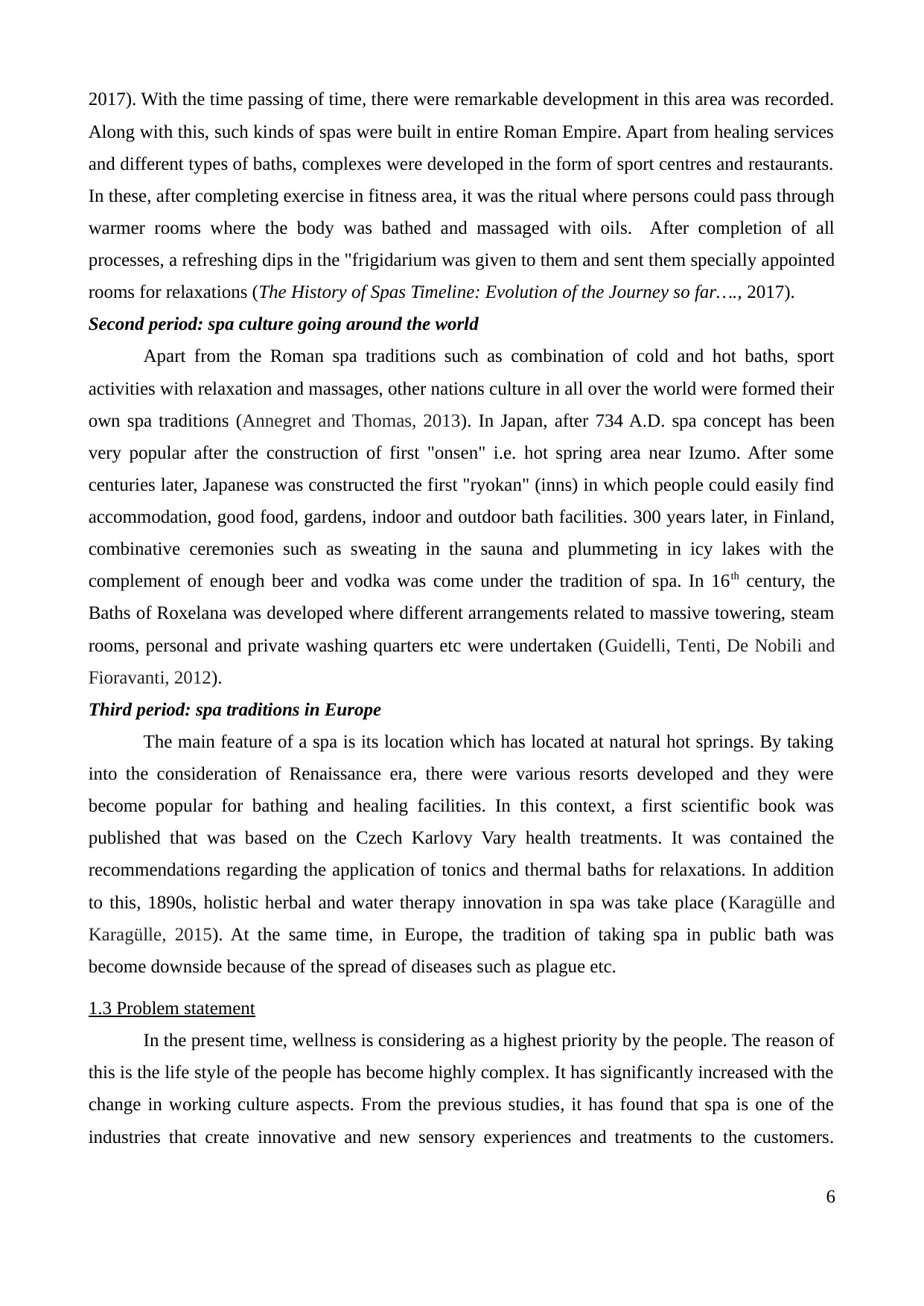
2017). With the time passing of time, there were remarkable development in this area was recorded.
Along with this, such kinds of spas were built in entire Roman Empire. Apart from healing services
and different types of baths, complexes were developed in the form of sport centres and restaurants.
In these, after completing exercise in fitness area, it was the ritual where persons could pass through
warmer rooms where the body was bathed and massaged with oils. After completion of all
processes, a refreshing dips in the "frigidarium was given to them and sent them specially appointed
rooms for relaxations (The History of Spas Timeline: Evolution of the Journey so far…., 2017).
Second period: spa culture going around the world
Apart from the Roman spa traditions such as combination of cold and hot baths, sport
activities with relaxation and massages, other nations culture in all over the world were formed their
own spa traditions (Annegret and Thomas, 2013). In Japan, after 734 A.D. spa concept has been
very popular after the construction of first "onsen" i.e. hot spring area near Izumo. After some
centuries later, Japanese was constructed the first "ryokan" (inns) in which people could easily find
accommodation, good food, gardens, indoor and outdoor bath facilities. 300 years later, in Finland,
combinative ceremonies such as sweating in the sauna and plummeting in icy lakes with the
complement of enough beer and vodka was come under the tradition of spa. In 16th century, the
Baths of Roxelana was developed where different arrangements related to massive towering, steam
rooms, personal and private washing quarters etc were undertaken (Guidelli, Tenti, De Nobili and
Fioravanti, 2012).
Third period: spa traditions in Europe
The main feature of a spa is its location which has located at natural hot springs. By taking
into the consideration of Renaissance era, there were various resorts developed and they were
become popular for bathing and healing facilities. In this context, a first scientific book was
published that was based on the Czech Karlovy Vary health treatments. It was contained the
recommendations regarding the application of tonics and thermal baths for relaxations. In addition
to this, 1890s, holistic herbal and water therapy innovation in spa was take place (Karagülle and
Karagülle, 2015). At the same time, in Europe, the tradition of taking spa in public bath was
become downside because of the spread of diseases such as plague etc.
1.3 Problem statement
In the present time, wellness is considering as a highest priority by the people. The reason of
this is the life style of the people has become highly complex. It has significantly increased with the
change in working culture aspects. From the previous studies, it has found that spa is one of the
industries that create innovative and new sensory experiences and treatments to the customers.
6
Along with this, such kinds of spas were built in entire Roman Empire. Apart from healing services
and different types of baths, complexes were developed in the form of sport centres and restaurants.
In these, after completing exercise in fitness area, it was the ritual where persons could pass through
warmer rooms where the body was bathed and massaged with oils. After completion of all
processes, a refreshing dips in the "frigidarium was given to them and sent them specially appointed
rooms for relaxations (The History of Spas Timeline: Evolution of the Journey so far…., 2017).
Second period: spa culture going around the world
Apart from the Roman spa traditions such as combination of cold and hot baths, sport
activities with relaxation and massages, other nations culture in all over the world were formed their
own spa traditions (Annegret and Thomas, 2013). In Japan, after 734 A.D. spa concept has been
very popular after the construction of first "onsen" i.e. hot spring area near Izumo. After some
centuries later, Japanese was constructed the first "ryokan" (inns) in which people could easily find
accommodation, good food, gardens, indoor and outdoor bath facilities. 300 years later, in Finland,
combinative ceremonies such as sweating in the sauna and plummeting in icy lakes with the
complement of enough beer and vodka was come under the tradition of spa. In 16th century, the
Baths of Roxelana was developed where different arrangements related to massive towering, steam
rooms, personal and private washing quarters etc were undertaken (Guidelli, Tenti, De Nobili and
Fioravanti, 2012).
Third period: spa traditions in Europe
The main feature of a spa is its location which has located at natural hot springs. By taking
into the consideration of Renaissance era, there were various resorts developed and they were
become popular for bathing and healing facilities. In this context, a first scientific book was
published that was based on the Czech Karlovy Vary health treatments. It was contained the
recommendations regarding the application of tonics and thermal baths for relaxations. In addition
to this, 1890s, holistic herbal and water therapy innovation in spa was take place (Karagülle and
Karagülle, 2015). At the same time, in Europe, the tradition of taking spa in public bath was
become downside because of the spread of diseases such as plague etc.
1.3 Problem statement
In the present time, wellness is considering as a highest priority by the people. The reason of
this is the life style of the people has become highly complex. It has significantly increased with the
change in working culture aspects. From the previous studies, it has found that spa is one of the
industries that create innovative and new sensory experiences and treatments to the customers.
6
⊘ This is a preview!⊘
Do you want full access?
Subscribe today to unlock all pages.

Trusted by 1+ million students worldwide
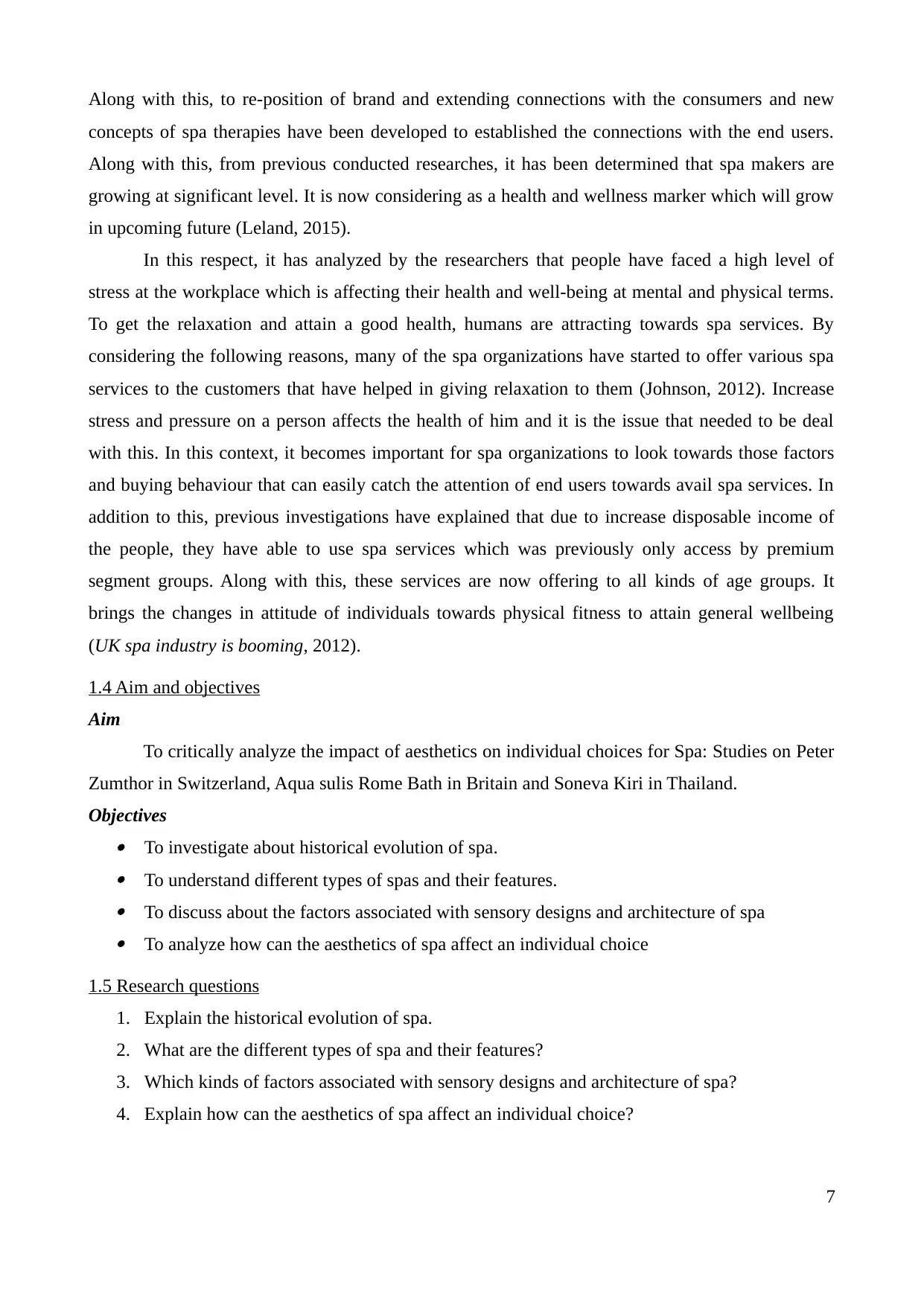
Along with this, to re-position of brand and extending connections with the consumers and new
concepts of spa therapies have been developed to established the connections with the end users.
Along with this, from previous conducted researches, it has been determined that spa makers are
growing at significant level. It is now considering as a health and wellness marker which will grow
in upcoming future (Leland, 2015).
In this respect, it has analyzed by the researchers that people have faced a high level of
stress at the workplace which is affecting their health and well-being at mental and physical terms.
To get the relaxation and attain a good health, humans are attracting towards spa services. By
considering the following reasons, many of the spa organizations have started to offer various spa
services to the customers that have helped in giving relaxation to them (Johnson, 2012). Increase
stress and pressure on a person affects the health of him and it is the issue that needed to be deal
with this. In this context, it becomes important for spa organizations to look towards those factors
and buying behaviour that can easily catch the attention of end users towards avail spa services. In
addition to this, previous investigations have explained that due to increase disposable income of
the people, they have able to use spa services which was previously only access by premium
segment groups. Along with this, these services are now offering to all kinds of age groups. It
brings the changes in attitude of individuals towards physical fitness to attain general wellbeing
(UK spa industry is booming, 2012).
1.4 Aim and objectives
Aim
To critically analyze the impact of aesthetics on individual choices for Spa: Studies on Peter
Zumthor in Switzerland, Aqua sulis Rome Bath in Britain and Soneva Kiri in Thailand.
Objectives To investigate about historical evolution of spa. To understand different types of spas and their features. To discuss about the factors associated with sensory designs and architecture of spa To analyze how can the aesthetics of spa affect an individual choice
1.5 Research questions
1. Explain the historical evolution of spa.
2. What are the different types of spa and their features?
3. Which kinds of factors associated with sensory designs and architecture of spa?
4. Explain how can the aesthetics of spa affect an individual choice?
7
concepts of spa therapies have been developed to established the connections with the end users.
Along with this, from previous conducted researches, it has been determined that spa makers are
growing at significant level. It is now considering as a health and wellness marker which will grow
in upcoming future (Leland, 2015).
In this respect, it has analyzed by the researchers that people have faced a high level of
stress at the workplace which is affecting their health and well-being at mental and physical terms.
To get the relaxation and attain a good health, humans are attracting towards spa services. By
considering the following reasons, many of the spa organizations have started to offer various spa
services to the customers that have helped in giving relaxation to them (Johnson, 2012). Increase
stress and pressure on a person affects the health of him and it is the issue that needed to be deal
with this. In this context, it becomes important for spa organizations to look towards those factors
and buying behaviour that can easily catch the attention of end users towards avail spa services. In
addition to this, previous investigations have explained that due to increase disposable income of
the people, they have able to use spa services which was previously only access by premium
segment groups. Along with this, these services are now offering to all kinds of age groups. It
brings the changes in attitude of individuals towards physical fitness to attain general wellbeing
(UK spa industry is booming, 2012).
1.4 Aim and objectives
Aim
To critically analyze the impact of aesthetics on individual choices for Spa: Studies on Peter
Zumthor in Switzerland, Aqua sulis Rome Bath in Britain and Soneva Kiri in Thailand.
Objectives To investigate about historical evolution of spa. To understand different types of spas and their features. To discuss about the factors associated with sensory designs and architecture of spa To analyze how can the aesthetics of spa affect an individual choice
1.5 Research questions
1. Explain the historical evolution of spa.
2. What are the different types of spa and their features?
3. Which kinds of factors associated with sensory designs and architecture of spa?
4. Explain how can the aesthetics of spa affect an individual choice?
7
Paraphrase This Document
Need a fresh take? Get an instant paraphrase of this document with our AI Paraphraser
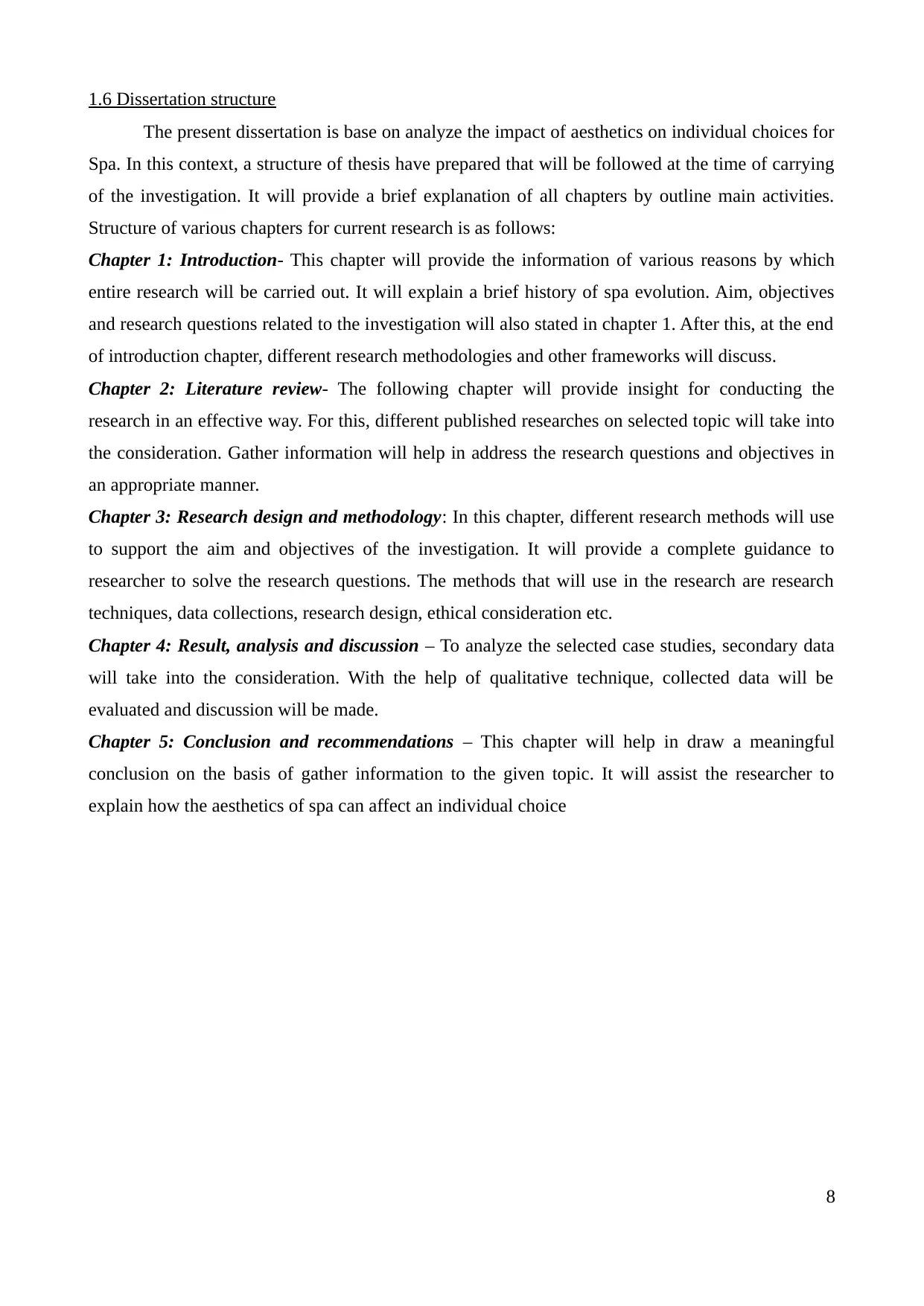
1.6 Dissertation structure
The present dissertation is base on analyze the impact of aesthetics on individual choices for
Spa. In this context, a structure of thesis have prepared that will be followed at the time of carrying
of the investigation. It will provide a brief explanation of all chapters by outline main activities.
Structure of various chapters for current research is as follows:
Chapter 1: Introduction- This chapter will provide the information of various reasons by which
entire research will be carried out. It will explain a brief history of spa evolution. Aim, objectives
and research questions related to the investigation will also stated in chapter 1. After this, at the end
of introduction chapter, different research methodologies and other frameworks will discuss.
Chapter 2: Literature review- The following chapter will provide insight for conducting the
research in an effective way. For this, different published researches on selected topic will take into
the consideration. Gather information will help in address the research questions and objectives in
an appropriate manner.
Chapter 3: Research design and methodology: In this chapter, different research methods will use
to support the aim and objectives of the investigation. It will provide a complete guidance to
researcher to solve the research questions. The methods that will use in the research are research
techniques, data collections, research design, ethical consideration etc.
Chapter 4: Result, analysis and discussion – To analyze the selected case studies, secondary data
will take into the consideration. With the help of qualitative technique, collected data will be
evaluated and discussion will be made.
Chapter 5: Conclusion and recommendations – This chapter will help in draw a meaningful
conclusion on the basis of gather information to the given topic. It will assist the researcher to
explain how the aesthetics of spa can affect an individual choice
8
The present dissertation is base on analyze the impact of aesthetics on individual choices for
Spa. In this context, a structure of thesis have prepared that will be followed at the time of carrying
of the investigation. It will provide a brief explanation of all chapters by outline main activities.
Structure of various chapters for current research is as follows:
Chapter 1: Introduction- This chapter will provide the information of various reasons by which
entire research will be carried out. It will explain a brief history of spa evolution. Aim, objectives
and research questions related to the investigation will also stated in chapter 1. After this, at the end
of introduction chapter, different research methodologies and other frameworks will discuss.
Chapter 2: Literature review- The following chapter will provide insight for conducting the
research in an effective way. For this, different published researches on selected topic will take into
the consideration. Gather information will help in address the research questions and objectives in
an appropriate manner.
Chapter 3: Research design and methodology: In this chapter, different research methods will use
to support the aim and objectives of the investigation. It will provide a complete guidance to
researcher to solve the research questions. The methods that will use in the research are research
techniques, data collections, research design, ethical consideration etc.
Chapter 4: Result, analysis and discussion – To analyze the selected case studies, secondary data
will take into the consideration. With the help of qualitative technique, collected data will be
evaluated and discussion will be made.
Chapter 5: Conclusion and recommendations – This chapter will help in draw a meaningful
conclusion on the basis of gather information to the given topic. It will assist the researcher to
explain how the aesthetics of spa can affect an individual choice
8
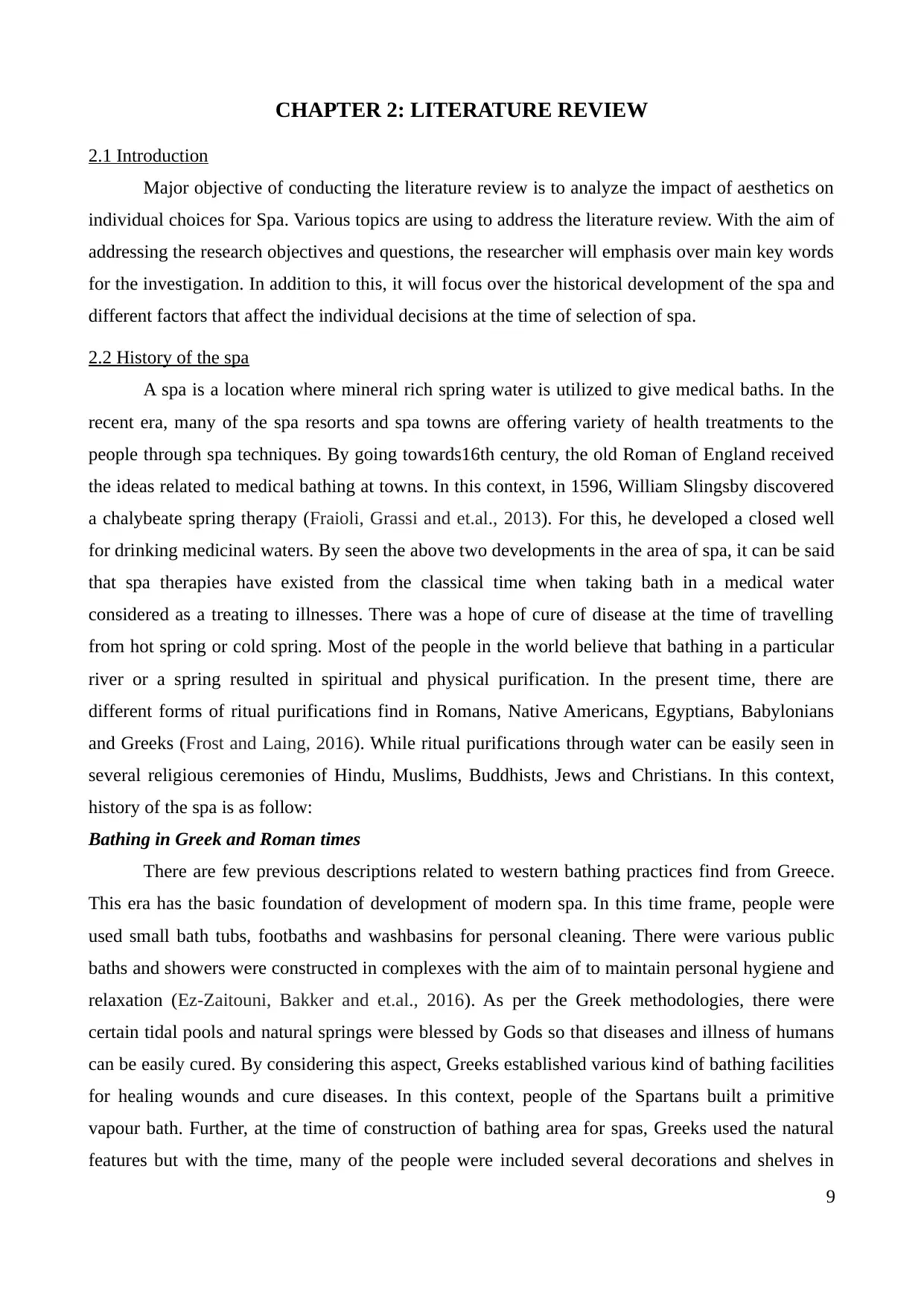
CHAPTER 2: LITERATURE REVIEW
2.1 Introduction
Major objective of conducting the literature review is to analyze the impact of aesthetics on
individual choices for Spa. Various topics are using to address the literature review. With the aim of
addressing the research objectives and questions, the researcher will emphasis over main key words
for the investigation. In addition to this, it will focus over the historical development of the spa and
different factors that affect the individual decisions at the time of selection of spa.
2.2 History of the spa
A spa is a location where mineral rich spring water is utilized to give medical baths. In the
recent era, many of the spa resorts and spa towns are offering variety of health treatments to the
people through spa techniques. By going towards16th century, the old Roman of England received
the ideas related to medical bathing at towns. In this context, in 1596, William Slingsby discovered
a chalybeate spring therapy (Fraioli, Grassi and et.al., 2013). For this, he developed a closed well
for drinking medicinal waters. By seen the above two developments in the area of spa, it can be said
that spa therapies have existed from the classical time when taking bath in a medical water
considered as a treating to illnesses. There was a hope of cure of disease at the time of travelling
from hot spring or cold spring. Most of the people in the world believe that bathing in a particular
river or a spring resulted in spiritual and physical purification. In the present time, there are
different forms of ritual purifications find in Romans, Native Americans, Egyptians, Babylonians
and Greeks (Frost and Laing, 2016). While ritual purifications through water can be easily seen in
several religious ceremonies of Hindu, Muslims, Buddhists, Jews and Christians. In this context,
history of the spa is as follow:
Bathing in Greek and Roman times
There are few previous descriptions related to western bathing practices find from Greece.
This era has the basic foundation of development of modern spa. In this time frame, people were
used small bath tubs, footbaths and washbasins for personal cleaning. There were various public
baths and showers were constructed in complexes with the aim of to maintain personal hygiene and
relaxation (Ez-Zaitouni, Bakker and et.al., 2016). As per the Greek methodologies, there were
certain tidal pools and natural springs were blessed by Gods so that diseases and illness of humans
can be easily cured. By considering this aspect, Greeks established various kind of bathing facilities
for healing wounds and cure diseases. In this context, people of the Spartans built a primitive
vapour bath. Further, at the time of construction of bathing area for spas, Greeks used the natural
features but with the time, many of the people were included several decorations and shelves in
9
2.1 Introduction
Major objective of conducting the literature review is to analyze the impact of aesthetics on
individual choices for Spa. Various topics are using to address the literature review. With the aim of
addressing the research objectives and questions, the researcher will emphasis over main key words
for the investigation. In addition to this, it will focus over the historical development of the spa and
different factors that affect the individual decisions at the time of selection of spa.
2.2 History of the spa
A spa is a location where mineral rich spring water is utilized to give medical baths. In the
recent era, many of the spa resorts and spa towns are offering variety of health treatments to the
people through spa techniques. By going towards16th century, the old Roman of England received
the ideas related to medical bathing at towns. In this context, in 1596, William Slingsby discovered
a chalybeate spring therapy (Fraioli, Grassi and et.al., 2013). For this, he developed a closed well
for drinking medicinal waters. By seen the above two developments in the area of spa, it can be said
that spa therapies have existed from the classical time when taking bath in a medical water
considered as a treating to illnesses. There was a hope of cure of disease at the time of travelling
from hot spring or cold spring. Most of the people in the world believe that bathing in a particular
river or a spring resulted in spiritual and physical purification. In the present time, there are
different forms of ritual purifications find in Romans, Native Americans, Egyptians, Babylonians
and Greeks (Frost and Laing, 2016). While ritual purifications through water can be easily seen in
several religious ceremonies of Hindu, Muslims, Buddhists, Jews and Christians. In this context,
history of the spa is as follow:
Bathing in Greek and Roman times
There are few previous descriptions related to western bathing practices find from Greece.
This era has the basic foundation of development of modern spa. In this time frame, people were
used small bath tubs, footbaths and washbasins for personal cleaning. There were various public
baths and showers were constructed in complexes with the aim of to maintain personal hygiene and
relaxation (Ez-Zaitouni, Bakker and et.al., 2016). As per the Greek methodologies, there were
certain tidal pools and natural springs were blessed by Gods so that diseases and illness of humans
can be easily cured. By considering this aspect, Greeks established various kind of bathing facilities
for healing wounds and cure diseases. In this context, people of the Spartans built a primitive
vapour bath. Further, at the time of construction of bathing area for spas, Greeks used the natural
features but with the time, many of the people were included several decorations and shelves in
9
⊘ This is a preview!⊘
Do you want full access?
Subscribe today to unlock all pages.

Trusted by 1+ million students worldwide
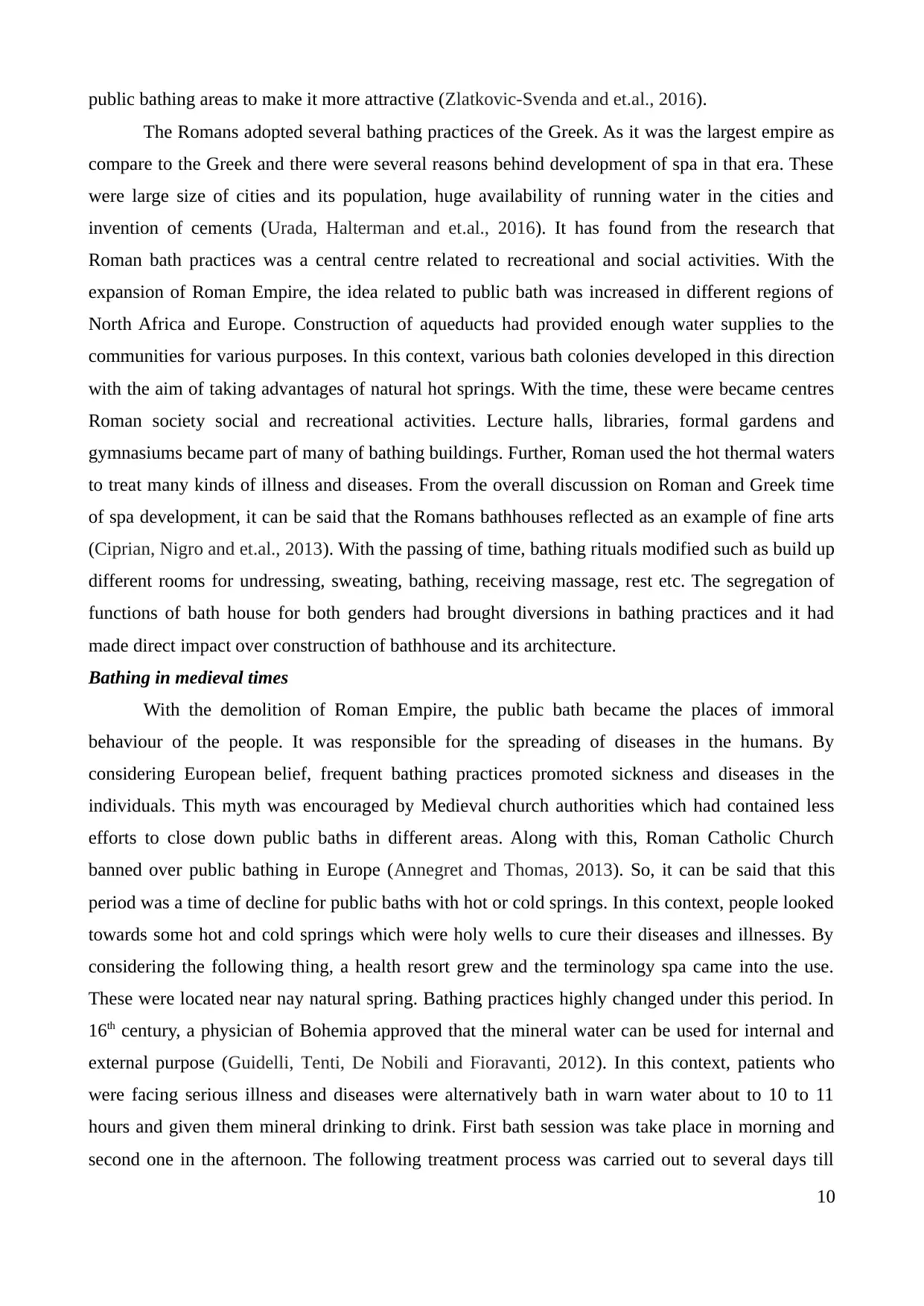
public bathing areas to make it more attractive (Zlatkovic-Svenda and et.al., 2016).
The Romans adopted several bathing practices of the Greek. As it was the largest empire as
compare to the Greek and there were several reasons behind development of spa in that era. These
were large size of cities and its population, huge availability of running water in the cities and
invention of cements (Urada, Halterman and et.al., 2016). It has found from the research that
Roman bath practices was a central centre related to recreational and social activities. With the
expansion of Roman Empire, the idea related to public bath was increased in different regions of
North Africa and Europe. Construction of aqueducts had provided enough water supplies to the
communities for various purposes. In this context, various bath colonies developed in this direction
with the aim of taking advantages of natural hot springs. With the time, these were became centres
Roman society social and recreational activities. Lecture halls, libraries, formal gardens and
gymnasiums became part of many of bathing buildings. Further, Roman used the hot thermal waters
to treat many kinds of illness and diseases. From the overall discussion on Roman and Greek time
of spa development, it can be said that the Romans bathhouses reflected as an example of fine arts
(Ciprian, Nigro and et.al., 2013). With the passing of time, bathing rituals modified such as build up
different rooms for undressing, sweating, bathing, receiving massage, rest etc. The segregation of
functions of bath house for both genders had brought diversions in bathing practices and it had
made direct impact over construction of bathhouse and its architecture.
Bathing in medieval times
With the demolition of Roman Empire, the public bath became the places of immoral
behaviour of the people. It was responsible for the spreading of diseases in the humans. By
considering European belief, frequent bathing practices promoted sickness and diseases in the
individuals. This myth was encouraged by Medieval church authorities which had contained less
efforts to close down public baths in different areas. Along with this, Roman Catholic Church
banned over public bathing in Europe (Annegret and Thomas, 2013). So, it can be said that this
period was a time of decline for public baths with hot or cold springs. In this context, people looked
towards some hot and cold springs which were holy wells to cure their diseases and illnesses. By
considering the following thing, a health resort grew and the terminology spa came into the use.
These were located near nay natural spring. Bathing practices highly changed under this period. In
16th century, a physician of Bohemia approved that the mineral water can be used for internal and
external purpose (Guidelli, Tenti, De Nobili and Fioravanti, 2012). In this context, patients who
were facing serious illness and diseases were alternatively bath in warn water about to 10 to 11
hours and given them mineral drinking to drink. First bath session was take place in morning and
second one in the afternoon. The following treatment process was carried out to several days till
10
The Romans adopted several bathing practices of the Greek. As it was the largest empire as
compare to the Greek and there were several reasons behind development of spa in that era. These
were large size of cities and its population, huge availability of running water in the cities and
invention of cements (Urada, Halterman and et.al., 2016). It has found from the research that
Roman bath practices was a central centre related to recreational and social activities. With the
expansion of Roman Empire, the idea related to public bath was increased in different regions of
North Africa and Europe. Construction of aqueducts had provided enough water supplies to the
communities for various purposes. In this context, various bath colonies developed in this direction
with the aim of taking advantages of natural hot springs. With the time, these were became centres
Roman society social and recreational activities. Lecture halls, libraries, formal gardens and
gymnasiums became part of many of bathing buildings. Further, Roman used the hot thermal waters
to treat many kinds of illness and diseases. From the overall discussion on Roman and Greek time
of spa development, it can be said that the Romans bathhouses reflected as an example of fine arts
(Ciprian, Nigro and et.al., 2013). With the passing of time, bathing rituals modified such as build up
different rooms for undressing, sweating, bathing, receiving massage, rest etc. The segregation of
functions of bath house for both genders had brought diversions in bathing practices and it had
made direct impact over construction of bathhouse and its architecture.
Bathing in medieval times
With the demolition of Roman Empire, the public bath became the places of immoral
behaviour of the people. It was responsible for the spreading of diseases in the humans. By
considering European belief, frequent bathing practices promoted sickness and diseases in the
individuals. This myth was encouraged by Medieval church authorities which had contained less
efforts to close down public baths in different areas. Along with this, Roman Catholic Church
banned over public bathing in Europe (Annegret and Thomas, 2013). So, it can be said that this
period was a time of decline for public baths with hot or cold springs. In this context, people looked
towards some hot and cold springs which were holy wells to cure their diseases and illnesses. By
considering the following thing, a health resort grew and the terminology spa came into the use.
These were located near nay natural spring. Bathing practices highly changed under this period. In
16th century, a physician of Bohemia approved that the mineral water can be used for internal and
external purpose (Guidelli, Tenti, De Nobili and Fioravanti, 2012). In this context, patients who
were facing serious illness and diseases were alternatively bath in warn water about to 10 to 11
hours and given them mineral drinking to drink. First bath session was take place in morning and
second one in the afternoon. The following treatment process was carried out to several days till
10
Paraphrase This Document
Need a fresh take? Get an instant paraphrase of this document with our AI Paraphraser
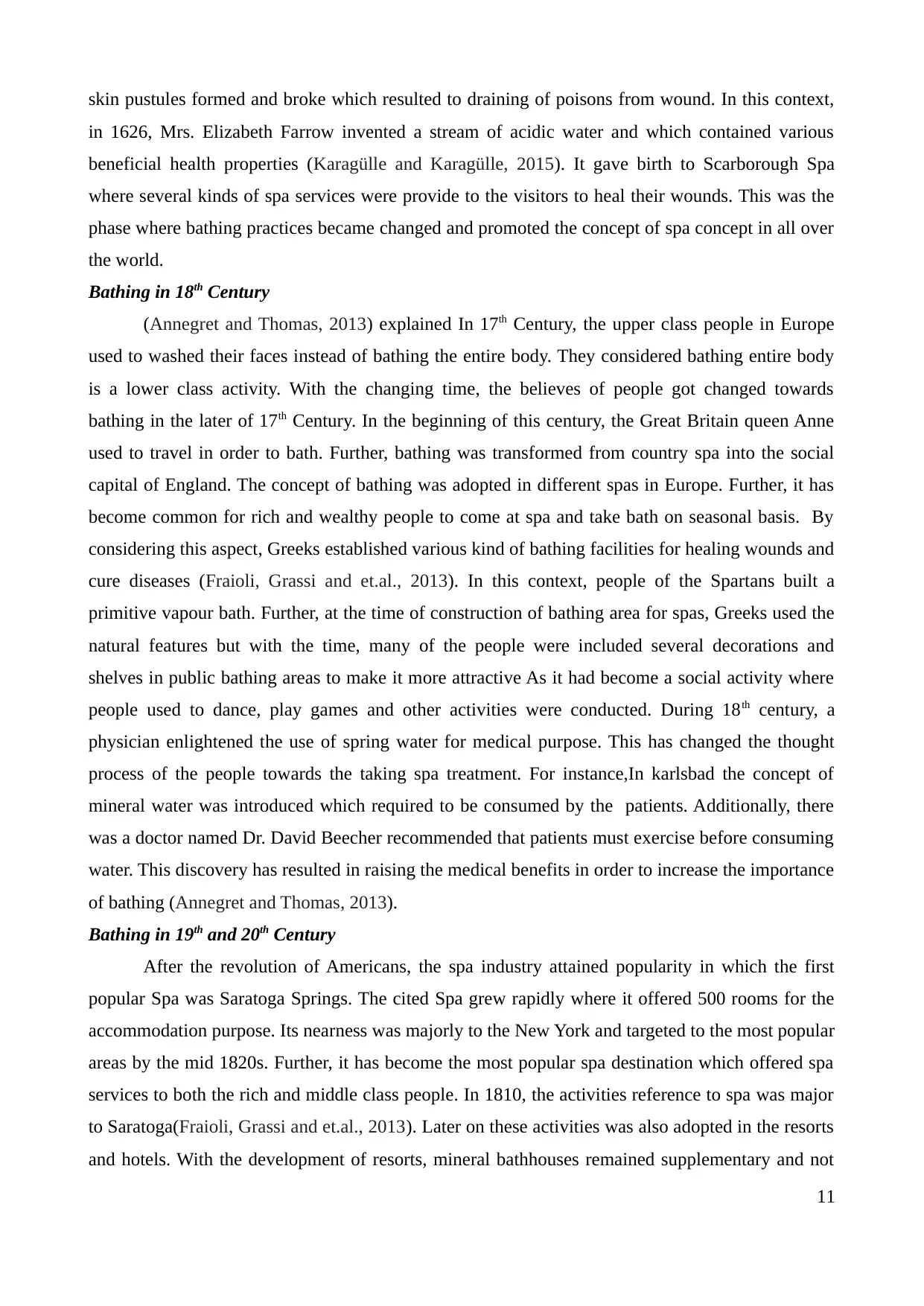
skin pustules formed and broke which resulted to draining of poisons from wound. In this context,
in 1626, Mrs. Elizabeth Farrow invented a stream of acidic water and which contained various
beneficial health properties (Karagülle and Karagülle, 2015). It gave birth to Scarborough Spa
where several kinds of spa services were provide to the visitors to heal their wounds. This was the
phase where bathing practices became changed and promoted the concept of spa concept in all over
the world.
Bathing in 18th Century
(Annegret and Thomas, 2013) explained In 17th Century, the upper class people in Europe
used to washed their faces instead of bathing the entire body. They considered bathing entire body
is a lower class activity. With the changing time, the believes of people got changed towards
bathing in the later of 17th Century. In the beginning of this century, the Great Britain queen Anne
used to travel in order to bath. Further, bathing was transformed from country spa into the social
capital of England. The concept of bathing was adopted in different spas in Europe. Further, it has
become common for rich and wealthy people to come at spa and take bath on seasonal basis. By
considering this aspect, Greeks established various kind of bathing facilities for healing wounds and
cure diseases (Fraioli, Grassi and et.al., 2013). In this context, people of the Spartans built a
primitive vapour bath. Further, at the time of construction of bathing area for spas, Greeks used the
natural features but with the time, many of the people were included several decorations and
shelves in public bathing areas to make it more attractive As it had become a social activity where
people used to dance, play games and other activities were conducted. During 18th century, a
physician enlightened the use of spring water for medical purpose. This has changed the thought
process of the people towards the taking spa treatment. For instance,In karlsbad the concept of
mineral water was introduced which required to be consumed by the patients. Additionally, there
was a doctor named Dr. David Beecher recommended that patients must exercise before consuming
water. This discovery has resulted in raising the medical benefits in order to increase the importance
of bathing (Annegret and Thomas, 2013).
Bathing in 19th and 20th Century
After the revolution of Americans, the spa industry attained popularity in which the first
popular Spa was Saratoga Springs. The cited Spa grew rapidly where it offered 500 rooms for the
accommodation purpose. Its nearness was majorly to the New York and targeted to the most popular
areas by the mid 1820s. Further, it has become the most popular spa destination which offered spa
services to both the rich and middle class people. In 1810, the activities reference to spa was major
to Saratoga(Fraioli, Grassi and et.al., 2013). Later on these activities was also adopted in the resorts
and hotels. With the development of resorts, mineral bathhouses remained supplementary and not
11
in 1626, Mrs. Elizabeth Farrow invented a stream of acidic water and which contained various
beneficial health properties (Karagülle and Karagülle, 2015). It gave birth to Scarborough Spa
where several kinds of spa services were provide to the visitors to heal their wounds. This was the
phase where bathing practices became changed and promoted the concept of spa concept in all over
the world.
Bathing in 18th Century
(Annegret and Thomas, 2013) explained In 17th Century, the upper class people in Europe
used to washed their faces instead of bathing the entire body. They considered bathing entire body
is a lower class activity. With the changing time, the believes of people got changed towards
bathing in the later of 17th Century. In the beginning of this century, the Great Britain queen Anne
used to travel in order to bath. Further, bathing was transformed from country spa into the social
capital of England. The concept of bathing was adopted in different spas in Europe. Further, it has
become common for rich and wealthy people to come at spa and take bath on seasonal basis. By
considering this aspect, Greeks established various kind of bathing facilities for healing wounds and
cure diseases (Fraioli, Grassi and et.al., 2013). In this context, people of the Spartans built a
primitive vapour bath. Further, at the time of construction of bathing area for spas, Greeks used the
natural features but with the time, many of the people were included several decorations and
shelves in public bathing areas to make it more attractive As it had become a social activity where
people used to dance, play games and other activities were conducted. During 18th century, a
physician enlightened the use of spring water for medical purpose. This has changed the thought
process of the people towards the taking spa treatment. For instance,In karlsbad the concept of
mineral water was introduced which required to be consumed by the patients. Additionally, there
was a doctor named Dr. David Beecher recommended that patients must exercise before consuming
water. This discovery has resulted in raising the medical benefits in order to increase the importance
of bathing (Annegret and Thomas, 2013).
Bathing in 19th and 20th Century
After the revolution of Americans, the spa industry attained popularity in which the first
popular Spa was Saratoga Springs. The cited Spa grew rapidly where it offered 500 rooms for the
accommodation purpose. Its nearness was majorly to the New York and targeted to the most popular
areas by the mid 1820s. Further, it has become the most popular spa destination which offered spa
services to both the rich and middle class people. In 1810, the activities reference to spa was major
to Saratoga(Fraioli, Grassi and et.al., 2013). Later on these activities was also adopted in the resorts
and hotels. With the development of resorts, mineral bathhouses remained supplementary and not
11
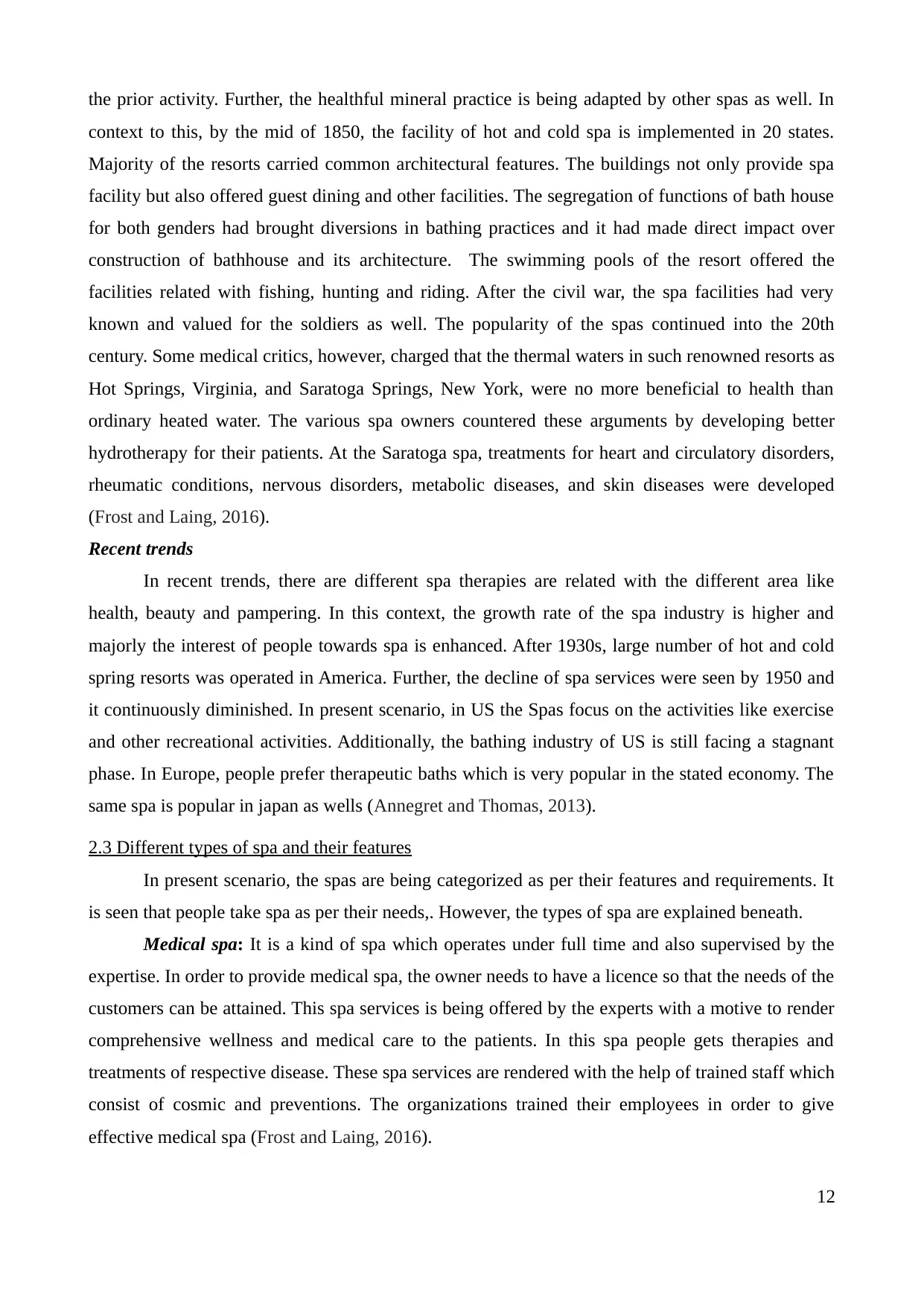
the prior activity. Further, the healthful mineral practice is being adapted by other spas as well. In
context to this, by the mid of 1850, the facility of hot and cold spa is implemented in 20 states.
Majority of the resorts carried common architectural features. The buildings not only provide spa
facility but also offered guest dining and other facilities. The segregation of functions of bath house
for both genders had brought diversions in bathing practices and it had made direct impact over
construction of bathhouse and its architecture. The swimming pools of the resort offered the
facilities related with fishing, hunting and riding. After the civil war, the spa facilities had very
known and valued for the soldiers as well. The popularity of the spas continued into the 20th
century. Some medical critics, however, charged that the thermal waters in such renowned resorts as
Hot Springs, Virginia, and Saratoga Springs, New York, were no more beneficial to health than
ordinary heated water. The various spa owners countered these arguments by developing better
hydrotherapy for their patients. At the Saratoga spa, treatments for heart and circulatory disorders,
rheumatic conditions, nervous disorders, metabolic diseases, and skin diseases were developed
(Frost and Laing, 2016).
Recent trends
In recent trends, there are different spa therapies are related with the different area like
health, beauty and pampering. In this context, the growth rate of the spa industry is higher and
majorly the interest of people towards spa is enhanced. After 1930s, large number of hot and cold
spring resorts was operated in America. Further, the decline of spa services were seen by 1950 and
it continuously diminished. In present scenario, in US the Spas focus on the activities like exercise
and other recreational activities. Additionally, the bathing industry of US is still facing a stagnant
phase. In Europe, people prefer therapeutic baths which is very popular in the stated economy. The
same spa is popular in japan as wells (Annegret and Thomas, 2013).
2.3 Different types of spa and their features
In present scenario, the spas are being categorized as per their features and requirements. It
is seen that people take spa as per their needs,. However, the types of spa are explained beneath.
Medical spa: It is a kind of spa which operates under full time and also supervised by the
expertise. In order to provide medical spa, the owner needs to have a licence so that the needs of the
customers can be attained. This spa services is being offered by the experts with a motive to render
comprehensive wellness and medical care to the patients. In this spa people gets therapies and
treatments of respective disease. These spa services are rendered with the help of trained staff which
consist of cosmic and preventions. The organizations trained their employees in order to give
effective medical spa (Frost and Laing, 2016).
12
context to this, by the mid of 1850, the facility of hot and cold spa is implemented in 20 states.
Majority of the resorts carried common architectural features. The buildings not only provide spa
facility but also offered guest dining and other facilities. The segregation of functions of bath house
for both genders had brought diversions in bathing practices and it had made direct impact over
construction of bathhouse and its architecture. The swimming pools of the resort offered the
facilities related with fishing, hunting and riding. After the civil war, the spa facilities had very
known and valued for the soldiers as well. The popularity of the spas continued into the 20th
century. Some medical critics, however, charged that the thermal waters in such renowned resorts as
Hot Springs, Virginia, and Saratoga Springs, New York, were no more beneficial to health than
ordinary heated water. The various spa owners countered these arguments by developing better
hydrotherapy for their patients. At the Saratoga spa, treatments for heart and circulatory disorders,
rheumatic conditions, nervous disorders, metabolic diseases, and skin diseases were developed
(Frost and Laing, 2016).
Recent trends
In recent trends, there are different spa therapies are related with the different area like
health, beauty and pampering. In this context, the growth rate of the spa industry is higher and
majorly the interest of people towards spa is enhanced. After 1930s, large number of hot and cold
spring resorts was operated in America. Further, the decline of spa services were seen by 1950 and
it continuously diminished. In present scenario, in US the Spas focus on the activities like exercise
and other recreational activities. Additionally, the bathing industry of US is still facing a stagnant
phase. In Europe, people prefer therapeutic baths which is very popular in the stated economy. The
same spa is popular in japan as wells (Annegret and Thomas, 2013).
2.3 Different types of spa and their features
In present scenario, the spas are being categorized as per their features and requirements. It
is seen that people take spa as per their needs,. However, the types of spa are explained beneath.
Medical spa: It is a kind of spa which operates under full time and also supervised by the
expertise. In order to provide medical spa, the owner needs to have a licence so that the needs of the
customers can be attained. This spa services is being offered by the experts with a motive to render
comprehensive wellness and medical care to the patients. In this spa people gets therapies and
treatments of respective disease. These spa services are rendered with the help of trained staff which
consist of cosmic and preventions. The organizations trained their employees in order to give
effective medical spa (Frost and Laing, 2016).
12
⊘ This is a preview!⊘
Do you want full access?
Subscribe today to unlock all pages.

Trusted by 1+ million students worldwide
1 out of 40
Related Documents
Your All-in-One AI-Powered Toolkit for Academic Success.
+13062052269
info@desklib.com
Available 24*7 on WhatsApp / Email
![[object Object]](/_next/static/media/star-bottom.7253800d.svg)
Unlock your academic potential
Copyright © 2020–2025 A2Z Services. All Rights Reserved. Developed and managed by ZUCOL.





